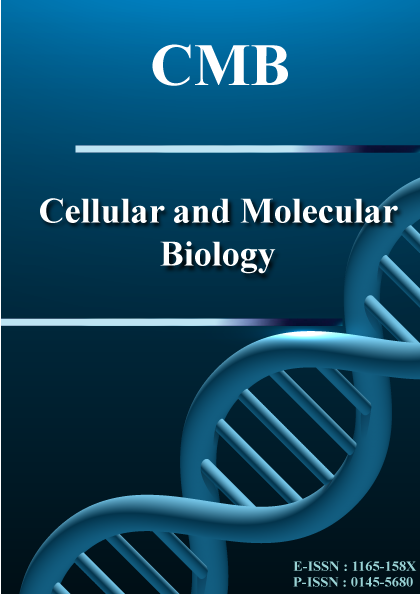Issue
Copyright (c) 2025 Najeh Krayem, Farah Jribi , MONA ALONAZI, Musarat Amina, Habib Horchani, Aida Karray, Slim Cherif, Abir Ben Bacha

This work is licensed under a Creative Commons Attribution-NonCommercial-NoDerivatives 4.0 International License.
The undersigned hereby assign all rights, included but not limited to copyright, for this manuscript to CMB Association upon its submission for consideration to publication on Cellular and Molecular Biology. The rights assigned include, but are not limited to, the sole and exclusive rights to license, sell, subsequently assign, derive, distribute, display and reproduce this manuscript, in whole or in part, in any format, electronic or otherwise, including those in existence at the time this agreement was signed. The authors hereby warrant that they have not granted or assigned, and shall not grant or assign, the aforementioned rights to any other person, firm, organization, or other entity. All rights are automatically restored to authors if this manuscript is not accepted for publication.Unveiling the therapeutic potential: anti-inflammatory and antioxidant properties of selective medicinal plants
Corresponding Author(s) : Abir Ben Bacha
Cellular and Molecular Biology,
Vol. 71 No. 3: Issue 3
Abstract
This study highlights the potential of plant extracts as sustainable and cost-effective alternatives to traditional anti-inflammatory drugs, owing to their rich bioactive compounds. The chemical composition and biological activities of ethanolic extracts from Artemisia campestris, Haloxylon articulatum, and Retama raetam were investigated. Extraction yields ranged from 2.94% to 6.84%, with A. campestris showing the highest phenolic content (85.59 ± 2.4 mg GAE/g) and R. raetam having the highest flavonoid concentration (34.77 ± 3.09 mg CE/g). HPLC analysis identified therapeutic phenolic and flavonoid compounds, including sinapic, quinic, and caffeic acids in A. campestris, p-coumaric acid in H. articulatum, and salicylic acid in R. raetam. Antimicrobial tests revealed that Gram-positive bacteria like Staphylococcus aureus and Bacillus cereus were sensitive to the extracts, though Gram-negative strains were unaffected. Antifungal activity was limited, with only H. articulatum showing inhibition of Rhizoctonia solani. Strong antioxidant activities were noted, particularly in H. articulatum and R. raetam extracts (IC50 = 130 µg/mL). In anti-inflammatory assays, all extracts exhibited dose-dependent inhibition of enzymes linked to inflammation, including COX-1, COX-2, 5-LOX, and sPLA2. A. campestris demonstrated the most potent inhibition, reaching 100% inhibition of sPLA2 at 200 μg/mL, while A. campestris and R. raetam provided significant protection in human red blood cell membrane stabilization assays. These results suggest that these plant extracts have considerable biological potential, especially in enzyme inhibition related to inflammation, making them promising candidates for future therapeutic use.
Keywords
Download Citation
Endnote/Zotero/Mendeley (RIS)BibTeX




